
Ben Bishop
Q: How did you discover art
It’s been more of an ongoing series of micro-discoveries I think; more of a process than a moment. And oddly, there was a long period of time when I un-discovered art.
At a very basic level, and from a very young age I loved drawing. In fact, one of my infants’ school teachers found that threatening me with “no drawing” worked very well as a deterrent against my various misbehaviours!
My appreciation of fine art was a little more delayed. When I was about five years old my parents took me to see Monet’s waterlilies. As we stood in the gallery, in front of those vast canvases, I can imagine their hoping that my mouth would drop as I underwent some creative epiphany. But instead, they were mortified by my immediate, loud and precocious boast that “I can do better than that!”.
Needless to say, I never bothered trying to back up that ridiculous boast. However, I did spend a lot of my childhood drawing. Drawing superheroes, spaceships, soldiers, rugby players, castles and monsters. My maternal Grandfather worked for a time in a paper mill, so I had an endless supply of off cuts at my disposal. I liked drawing. It was the thing I did best. Drawing became a niche that my young personality occupied; one of my defining characteristics. Even though I spend more time painting these days, I still enjoy drawing. There is a purity to it; an ease to the capture.
In my teenage years I began to realise that art could be a means of expression. Being a typical teen, my own artistic expressions were vehicles for showing the world how angst-ridden I was about its sorry state: Endless sketches of the crucifixion, and rather trite cartoons attacking America’s waging the first gulf war. But, also, if only as a bi-product of these whinging doodles, I began to take art more seriously as a school subject. I started to think about taking art at A-level and continuing on to art school. I did manage the A-level. My technique developed, as did my sense of myself as an artist. Art was no longer merely a way to get noticed, but a possible cornerstone of who I could be. But, as future plans began to crystalise, the opportunity to study History at Cambridge University proved too seductive. I dropped the art college idea, and in 1992 relegated my painting and drawing to a very occasional hobby for the next 26 years. I just put it in a box, and opened other lids.
…Jump forward to 2018. That year, a friend and I bought, renovated and sold a small terraced house in Gloucester. It was a wonderfully creative experience and we made a few quid each. Not a fortune, but a meaningful amount that presented me with the opportunity to turn back the clock to the early nineties and have my go at being an art student.
So, in September 2019 I ruffled my hair, scuffed up my shoes and practised my arty scowl in the mirror before setting off for my first day studying for a Fine Arts Foundation Degree at South Gloucestershire and Stroud College. All my recent works have emerged from that decision
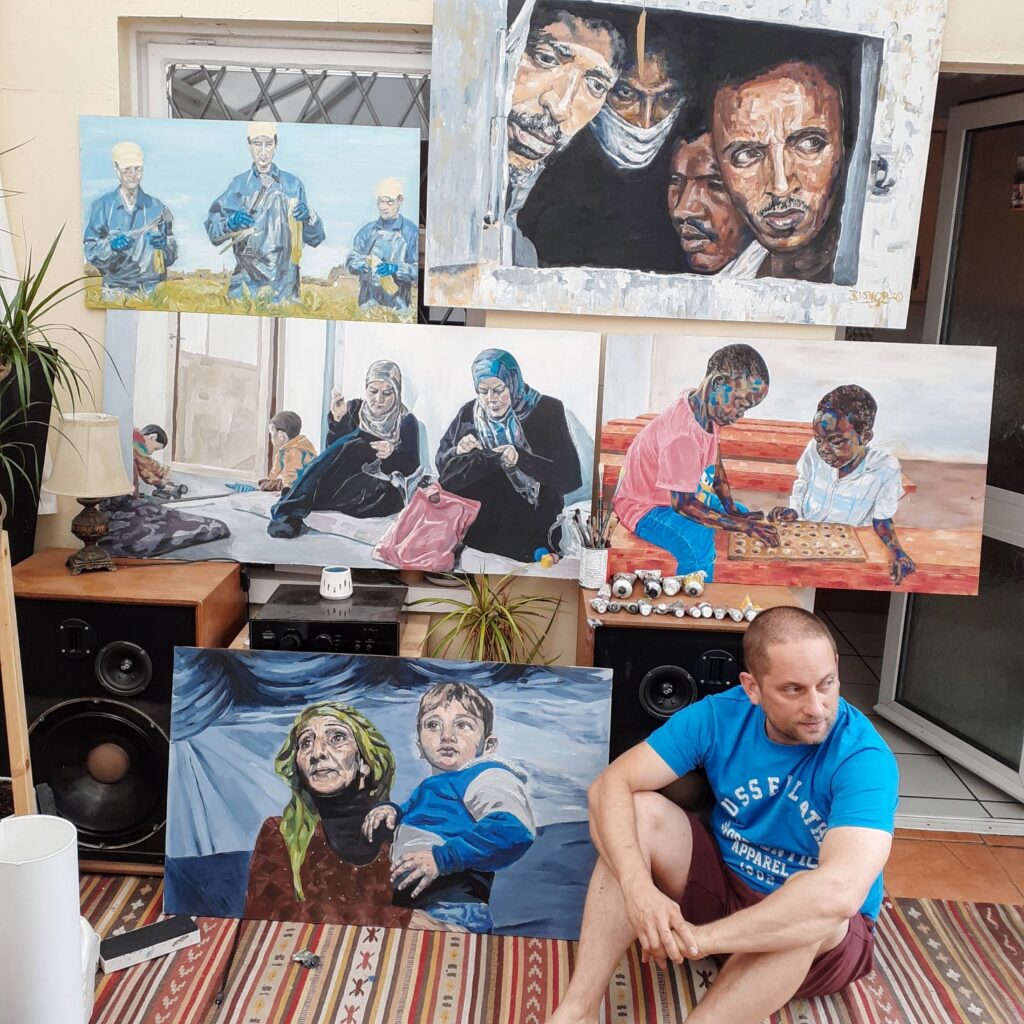
“One of my infants’ school teachers found that threatening me with “no drawing” worked very well”
Q. What are you trying to achieve in your art work?
For me, the ultimate answers are emotional ones: feelings of satisfaction and pride. Satisfaction that I have produced something that I can walk away from, and pride enough that I want others to see what I’ve done. The degree to which I achieve these emotional states seems dependent on two artistic achievements. Firstly, the form of the piece: I want to achieve an image that visually stimulates my own visual cortex. Looking at my finished pieces, I sometimes wonder whether my eyes have ADHD! It’s certainly the case that they are rarely satisfied with subtlety. Instead, choppy brush marks and flashes of colour often seem their order of the day.
Secondly, the substance: I want my work to express something that has meaning. Not necessarily profundity, but meaningl. I’ll say a bit more about that in one my later answers.

Red Green and Gold
Oil on board sketch 2020
£90 +P&P

Walter Cronkite
Oil on Canvas 2020
(Commission)
Q. What does a perfect creative experience look like to you?
My modest but honest answer is I don’t know; I’m not sure I’ve ever experienced creative perfection! That said, my best creative experiences seem to have been those that pressed me firmly into the present. It’s probably an experience that everyone seeks and achieves in different ways. That feeling of being alive. A complete absence of mentally replaying the past, or of imagining the future, and instead of being absorbed effortlessly by the present moment.
Getting close to this probably rests in part on elements beyond my control. However, some of the conditions that seem to maximise the chances of my achieving this state of immediacy are my creating the time and space for working, being alone, having a strong sense of motivation for the work and painting human subjects.
“Human connections have provided my life with its greatest sources of meaning”
Q. You seem to have a great deal of empathy with your subjects, why do you think this is?
Firstly, I felt delight when I read this question. That someone would write that about my work is for me a huge complement. So, thank you!
Human connections have provided my life with its greatest sources of meaning. Empathising with others, and having others empathise with me, are my most valuable experiences. My own relational proclivity is probably what has led me to train as a care worker, a teacher, and more recently as a counsellor and psychotherapist. All endeavours to which empathy is helpful. With regard to my artistic subjects, thinking about it now, I must have chosen them because I immediately empathised with them. So, if a viewer sees empathy in my work, then I consider that as a major success.
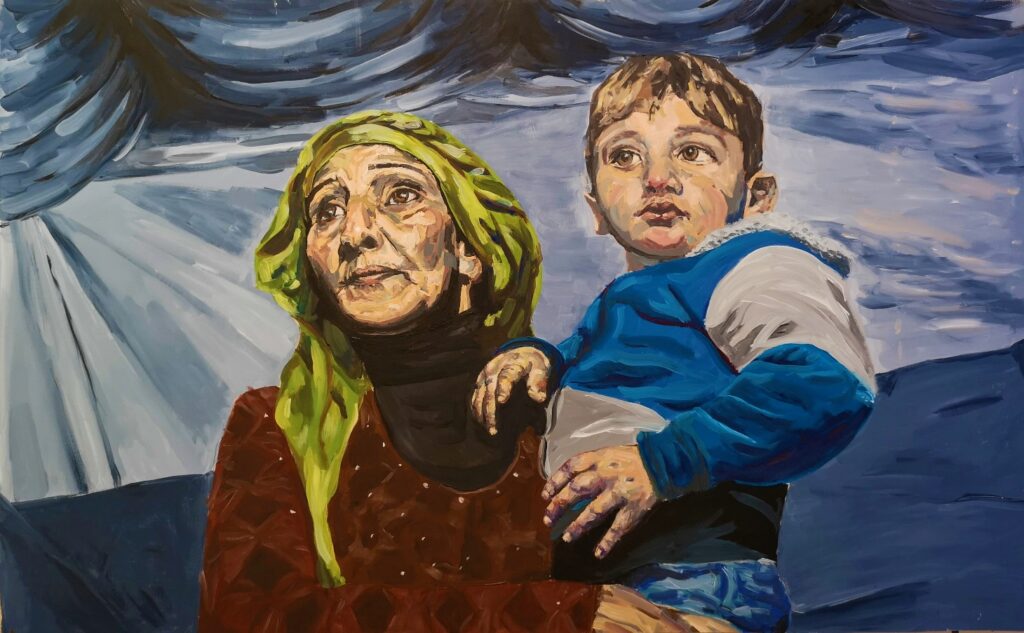
Grandmother and Child
Oil on Board 2020
Q. What has been your biggest creative challenge?
The answer would be at the top of a long list! And, it would probably be the painting of faces larger than life-size.
When producing oil paintings, I usually find myself wanting to paint in a painterly style. By that I mean the use of unblended and clear brush strokes that celebrate how the image was created. Inevitably, when one increases the scale of an image, an area of a face that in a smaller painting could be represented by a single brush stroke suddenly requires multiple marks. It’s like going from a standard definition TV to a 4K TV. One requires more pixels covering a larger area. So, larger paintings not only take more time, they also take a lot more creative effort.
Examples of painting when scale has presented exactly this creative challenge would be my “Men Behind Locked Door” (117cm wide) or the character portraits from “The Good, The Bad and The Ugly” (60cm wide).
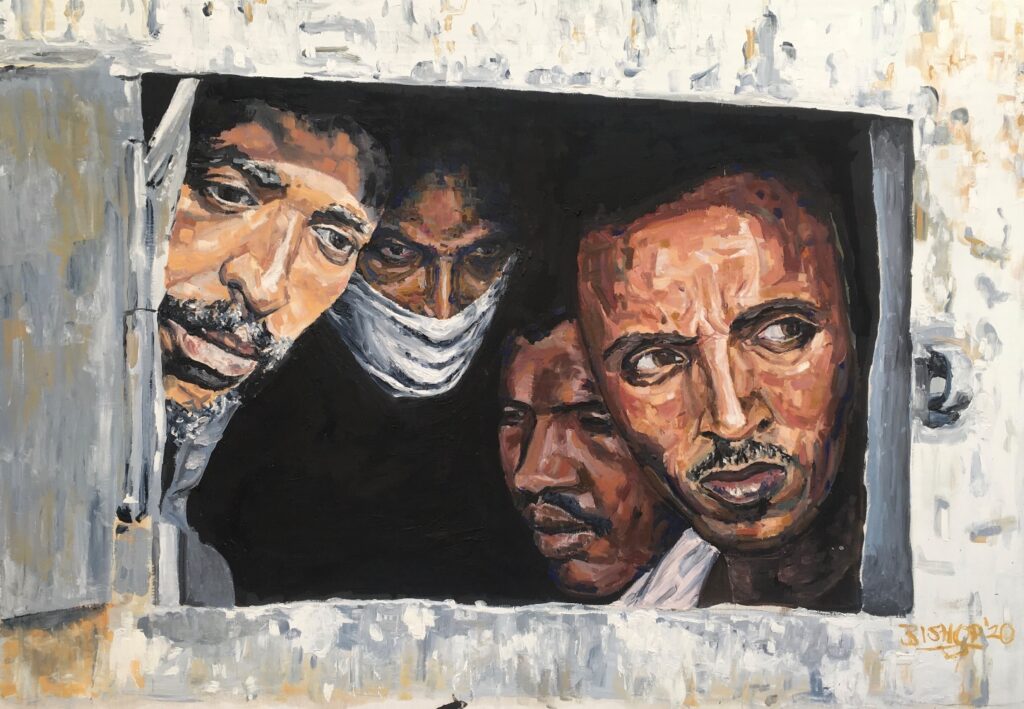
Men Behind Locked Door.
Oil on Board 2020
Q. People with learning disabilities and movie paintings are not normally found together, yet there is a consistent flow between the two. Why do you think this is?
I’m intrigued by this question, or rather by its predication. I don’t consciously seek to create a consistent flow between different series of my works. So, if there is a flow there, I’d like to think that it was generated naturally.
As mentioned above, when producing my own art (as opposed to a commission), I want to choose subjects to have meaning for me. I have found that meaningful subjects can emerge from my own values and beliefs, but also from cultural motifs that have become significant to me during my life. In either case, my subjects become my subjects because they are emblematic of something that matters to me. They are meaningful expressions.

Adults with learning disabilities
Mini-series 2020 £80 each + P&P

Crew of the Orca triptych
Oil on Canvas 2020 £295 + P&P for all three.
Humanism would be one of my core beliefs and values. Evolution another. I am fascinated by how the human brain has evolved to work tirelessly to categorise other humans based on some characteristic, and then to assign those humans some relevance or value based on that particular categorisation. I like to choose subjects that play around with this idea in my own head. Thinking about “Grandmother and Child” painting, Choosing a subject who could be categorised variously as a “woman” or as “old” or as a “grandmother” or as a “victim” or as a “human”, but who a mind like mine is possibly just as likely to categorise as a “Muslim” or as a “refugee”. By making such a person a subject of my art I give my own brain, and hopefully the brains of some the painting’s viewers, a bit of exercise. Similarly, with the paintings of people with learning disabilities I am asking what my brain is doing to define these people as individuals? Are they really just vessels for a learning disability?
This train of thought around the categorisation of others led to my painting “How Much Defines Us?”. The subject was a photograph of Anne Wafula-Strike. Anne is a person who is probably best-known as a Paralympic athlete, but who as a human being, is made up of many more parts than that. Anne has seen a photo of the painting, and thank goodness, seems to like it.
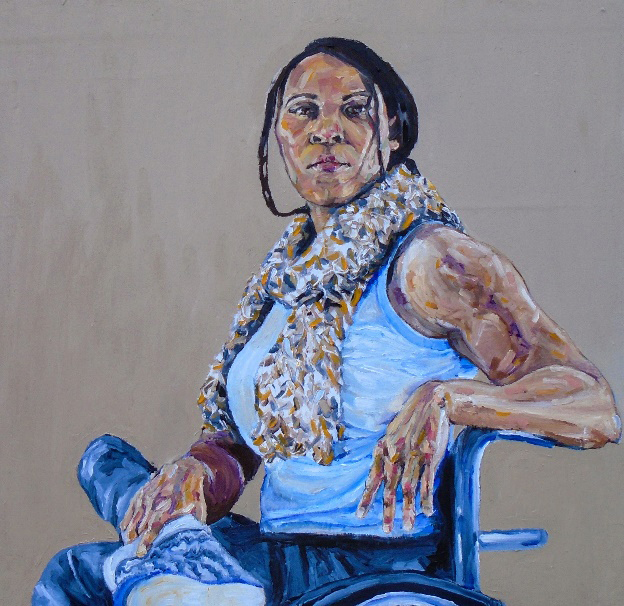
How Much Defines Us?
(Portrait of Anne Wafula Strike) Oil on board. 2020
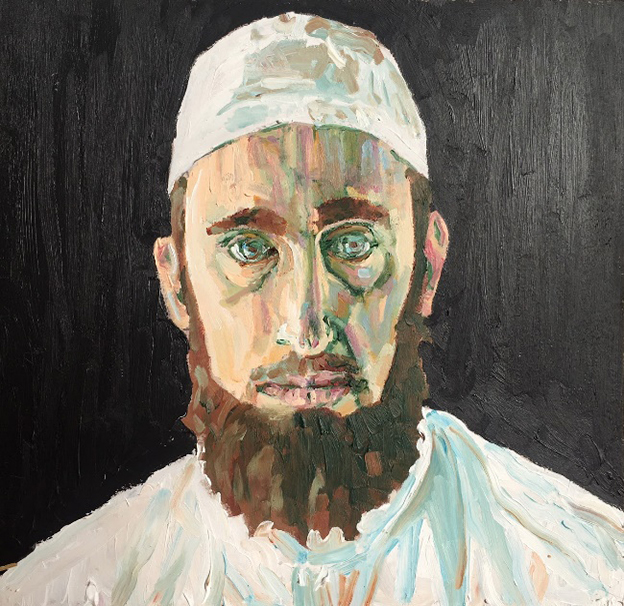
Man with Beard
Oil on Board 2020 £80 + P&P
My paintings of movie characters derive their meaning somewhat differently. They are based on films that have resonated with me for a long time. I have many memories of watching films like Jaws and The Good The Bad and The Ugly with my brother on grainy VHS tapes recorded from poor reception analogue TV. I was utterly spell bound by them. For me, such films are based on acting performances so strong that they convincingly convey multi-dimensional characters made of multiple diversities. The performances of Eli Wallach or Robert Shaw convey the complexity of the human condition that we can all experience automatically in ourselves, but that is far harder to perceive in others. Their characters, or more accurately their performances, facilitate empathy in those who watch their movies.
It’s important to acknowledge that there is also an economic pragmatism to painting movie characters. Paintings of film stars sell better than paintings of adults with learning disabilities. Last month I sold 9 movie paintings and one of someone with learning disabilities. At the moment I need to generate cash flow, so I am giving myself permission for some prostituting of my artistic soul. That said, the popular icons I chose had do be from those films that had most meaningful for me. In my Etsy shop, there are no ‘Benjamin Bishop Art’ oil paintings of Elsa from frozen or of Cristiano Ronaldo. I don’t have anything in principle against those subjects, it’s just that they don’t hold meaning for me.
Q. What have been your main influences?
I find myself somewhat more drawn to figurative than abstract art, so that has probably determined my influences. My favourite artists are Cezanne, Manet and Goya. But perhaps those are answers to a different question.
Some of my recent work has certainly been informed by the contemporary artists Michael Borremans and Luc Tuymans. Both are figurative and technically inspiring, but also a bit different too. One of my earliest works this year was an installation piece called “Socially Distanced”. It was inspired by Michael Borremans always painting his subjects with either closed eyes or averted gazes.
Additionally, there are some lesser known, but highly accomplished contemporary artists who I have come across on Instagram, and whose techniques I covet. Nicolás Uribe and Jane French would be two examples. There are just so many incredible artists out there. The trick is being able to feel inspired (“Wow! I could try something like that!”) rather than demoralised (“FFS. I could never manage anything like that.”) by their work!
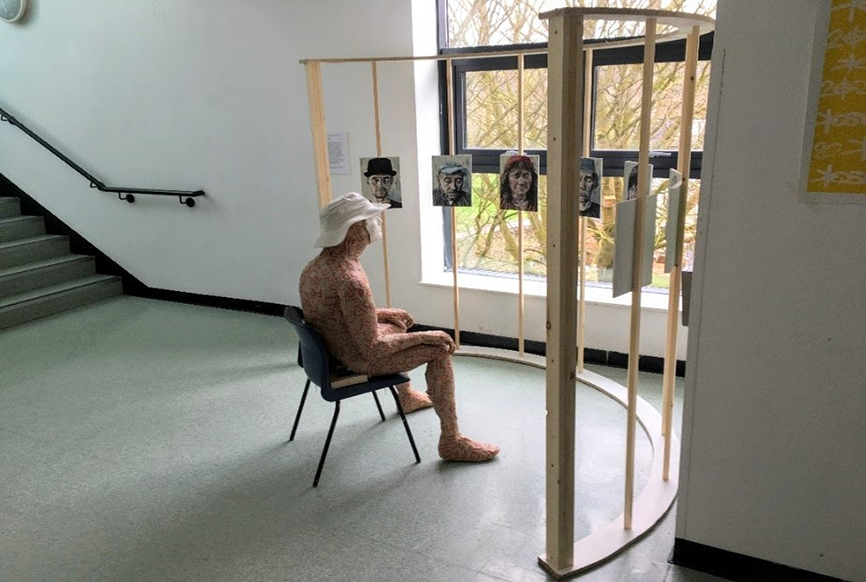
Socially Distanced. Installation. 2020.
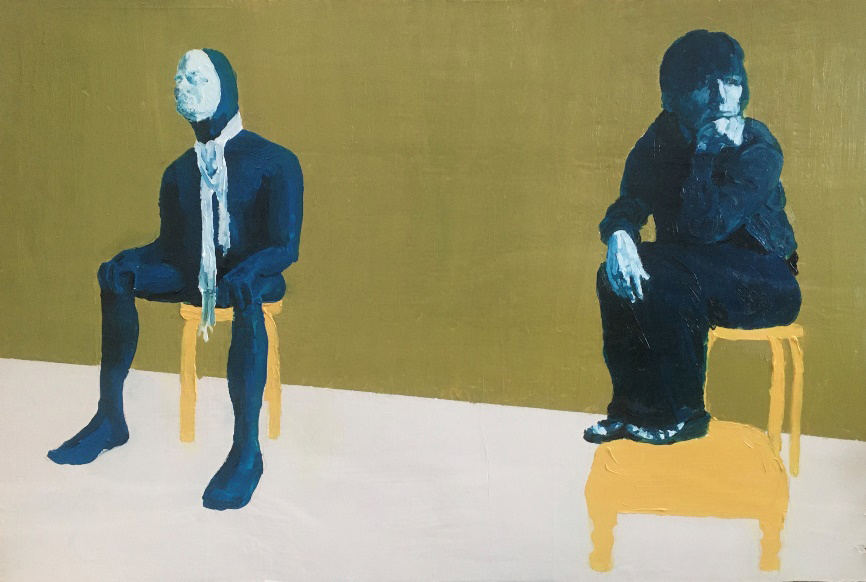
Two Metres. Oil on board. 2020.
And my painting “Two Metres” was heavily influenced by Tuymans’ painting “The Conversation”.
Q. What is your big ambition right now?
Put simply: To continue to generate a revenue stream from my painting. In the past six months I have put in a lot of time into producing my art and selling my art. And with some success. I am genuinely grateful to everyone who has supported my art. So many people have liked my images on social media (https://www.facebook.com/ColourfulMeanings and https://www.instagram.com/benjamin_bishop_art/ ), and made kind comments. Some have even bought my works! It’s all been wonderfully affirming. Similarly, being asked for this interview has been really flattering. And, thinking through these answers has also been a chance to reflect on the past 6 months. As a result, I am quite overwhelmed with disbelief and gratitude. Plus, a dash of hope about how things might progress. In twelve months’ time I will know with greater confidence whether recent successes could be sustained or whether the past few months have been a blip.
My other ambition is to get back to art college to complete my studies as soon as possible. After my first year I deferred due to the disruption caused to college life by the necessary covid restrictions. I want access to college studios, workshops, resources and face to face teaching. But access to all of those things has been greatly reduced. I will want to return when things are back to something closer to normal.
Q. What are the most satisfying parts of your work?
From a technical point of view: rendering a nose well. I find noses tricky! More fundamentally it’s satisfying when I think of a subject or a composition that I sense is congruent with what I want to express. Conceptualising that, and anticipating how successful a work might be when it’s actually finished makes me feel excited and motivated to work on it.
Q. What are the most frustrating parts of your work?
From a technical point of view: struggling to render a nose well. Or when I have some vague sense of something I want to express and I can’t think of a subject or composition that will do it justice.
It’s also frustrating when others feel differently about my work than I do. That can go either way. Either I’ll produce something that I think is the best thing I’ve ever done but the general response is “…meh”, or conversely, sometimes I’ll produced a work that I almost thew away because it didn’t turn out as well as I’d wanted it to, but other people love it. My first The Good The Bad and The Ugly series was like that. I spent ages on those three paintings and still never quite achieved what I wanted with them. Yet, I could’ve sold them a few times over in the first week. I suppose this would suggest that I don’t know much about art! (Nor about pricing.) 😀

The Good, The Bad, and The Ugly No1
Oil on Board 2020

The Good, The Bad and The Ugly No 2
Oil on Board 2020 Commission.
Q. What are you working on at the moment?
Right now, I am producing a series of 3 portraits of Audery Hepburn. It’s a commission. The customer was drawn to Hepburn as a teenager due to Hepburn’s many facets: Iconic, thoughtful and edgy. In an attempt to express this multi-facetedness I decided to paint three different poses in three slightly different styles. I kept the jumper colour the same across each, as I did the background, to pull them together. I am satisfied that they achieve what I set out to do. Fortunately, the client feels the same.

Although I find that I do experience some vicarious meaning from commissions, it is obviously a different experience than painting a subject of my own choosing. In the case of these Hepburn portraits, the customer was very communicative so I was able to get a very good understanding of why Hepburn held such meaning for her.
Next, I am hoping to spend some time to restock my Etsy shop (https://www.etsy.com/uk/shop/BenjaminBishopArt). After recent sales and a rush of commissions there has been a lot of shelf-emptying of my Etsy shop and precious little shelf-refilling, so I’d like to replenish things there a bit. I have some ideas for a few new works. Some will continue with the more commercially successful movie-based paintings, but also, I want to paint some original pieces. This year’s BLM discussions prompted some ideas for paintings, so expect to see something of those in the coming months.

